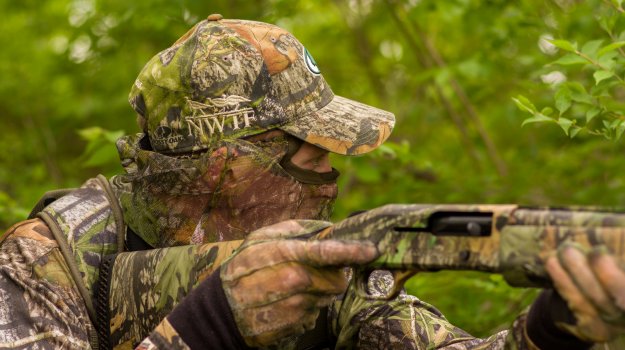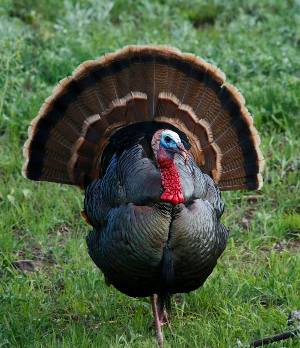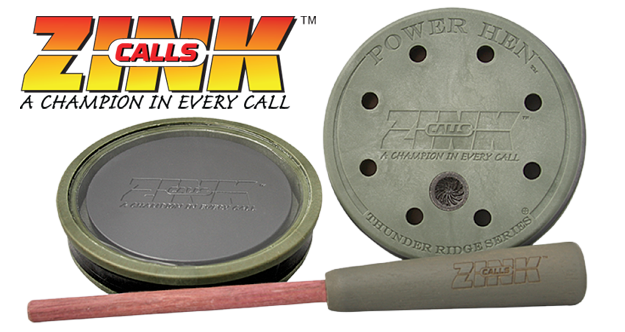with Bob Walker

I don’t want my hunter to have to hold his gun for a very long time, and I don’t want him to get fidgety. So, I make sure he’s in a good shooting position with his butt flat on the ground, his back supported by a tree trunk, his knees pulled up, and the gun resting on his knees, with his cheek against the stock and scanning and searching for the turkey. Then I tell my hunter, “Put both fingers on the safety of your gun, and push that safety off easy, so it doesn’t make a snapping sound. The only thing you should have to move is your eyes as you look for the turkey.” If you see the direction the turkey’s moving, and you spot a big tree he’ll have to walk behind, then get your hunter to make the final move with his shotgun. Then once the turkey steps out from behind the tree, all your hunter must do is put the bead on the tom’s wattles and squeeze the trigger.
 When I sit down behind my hunter, I’m on my knees rather than on my butt to be a bit above the hunter and looking right over his shoulder. Then I can see the same thing he sees. Also, being on my knees means I can get up quicker than my hunter can after the shot. Many times I’ll be able to see the turkey before the hunter does, and I want my mouth to be close to the hunter’s right ear, if he’s right-handed. I’ll start whispering to the hunter when I see the tom, “I’ll tell you if the turkey’s moving left or right of your gun barrel. If that turkey becomes alert, we won’t move a muscle. If he’s got his head up and looking hard, he’s trying to see that hen.” But all he may be able to do is hear me lightly scratching in the leaves. If he hears two scratches, a pause and then another scratch, he’ll usually pull his head back down and walk behind a tree or bush where he’s standing. If that turkey’s got his head up, pulls his wings up, tucks them and holds those wings in tight, he’s getting ready to run. And, if he starts to walk off, I’ll tell my hunter to shoot. However, if the bird doesn’t tuck his wings, he’ll generally lower his head and take one or two steps. If the turkey’s walking in, and I can’t see him, but my hunter can, I’ll whisper to my hunter “I can’t see the turkey. If you can and are ready to take the shot, and the turkey’s walking, I’ll whisper, ‘Now.’ I’ll yelp and stop the turkey, so you can take the shot. That turkey will stick his head up, and you’ll aim for the wattles and pull the trigger.”
When I sit down behind my hunter, I’m on my knees rather than on my butt to be a bit above the hunter and looking right over his shoulder. Then I can see the same thing he sees. Also, being on my knees means I can get up quicker than my hunter can after the shot. Many times I’ll be able to see the turkey before the hunter does, and I want my mouth to be close to the hunter’s right ear, if he’s right-handed. I’ll start whispering to the hunter when I see the tom, “I’ll tell you if the turkey’s moving left or right of your gun barrel. If that turkey becomes alert, we won’t move a muscle. If he’s got his head up and looking hard, he’s trying to see that hen.” But all he may be able to do is hear me lightly scratching in the leaves. If he hears two scratches, a pause and then another scratch, he’ll usually pull his head back down and walk behind a tree or bush where he’s standing. If that turkey’s got his head up, pulls his wings up, tucks them and holds those wings in tight, he’s getting ready to run. And, if he starts to walk off, I’ll tell my hunter to shoot. However, if the bird doesn’t tuck his wings, he’ll generally lower his head and take one or two steps. If the turkey’s walking in, and I can’t see him, but my hunter can, I’ll whisper to my hunter “I can’t see the turkey. If you can and are ready to take the shot, and the turkey’s walking, I’ll whisper, ‘Now.’ I’ll yelp and stop the turkey, so you can take the shot. That turkey will stick his head up, and you’ll aim for the wattles and pull the trigger.”
We sure don’t want to knock the turkey down and then let the bird get his feet back under him and run off, because then we probably won’t be able to recover him. Once I’m holding that dead turkey in my hand, the hunter’s usually gotten up and arrived at where I’m holding the turkey. That moment is what makes turkey guiding really worthwhile. There’ll usually be some high fives, hugging, whooping and hollering, and we’ll both be able to talk and relive what’s just happened. Then we’ll be looking at the turkey’s beard and his spurs, talking about the hunt and reminiscing about what a good time we’ve had together. That conversation will last all the way back to camp and continue with other hunters in the camp.
Day 3: Setting Up a Second Time 150-200 yards from a Gobbling Turkey
Tomorrow: What Happens Once the Hunter Makes the Shot and the Turkey’s Flopping






























